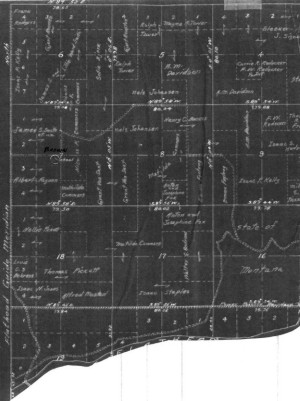The Spring Hill District #53 with the Brown School

Joyce Decker Wegner , County Superintendent
of Schools Lake County Country School
Historians.
also formed out of part of Green Mountain in 1911. The Brown School began September 1, 1911 about two miles north of the river. The building foundation was 24 feet by 40 feet and shows up on northeast corner of Albert Fagnan property in the southwest 1/4 of Section 7 of Township 22 North, Range 21 West. The Brown schoolhouse had 26 pupils the first year and the first teacher was Miss Carrie Redecker who homesteaded closer to Polson and rode her horse every day to school. The Literary Society gave plays and other enjoyable entertainment. A good debate was between Mr. James Sizemore and Lillie Smith on the Woman’s Suffrage. The planks for the stage were from Isaac Jones’ veranda. The school’s Christmas plays were a highlight of the school year also. Kenneth Lyons was to have a leading role in a play for Christmas and about three days before, his trusty horse kicked his front teeth out and how disappointed the others in the cast were. Many dances were held with Vic Nelson playing the violin and someone chording on the organ. Reverend Norris held church services and Sunday School in the school every Sabbath for many years. All community activities were at the school.

Early Irvine Flats School, Possibly
the Brown School from the setting,
or it could be in front of a teacherage.
[Hilbert Seines Collection]
As a fourth grader, Ida Jones remembers being one of three Brown School students who stood up for a spelling bee against Valley View Elementary.
Ida Jones went on to Flathead High School taking the "Normal Course." After graduation she taught two years at Big Bend School and then two more years at Green Mountain School in 1924 to 1926. Then she married Mr. Grund and they moved to Round Butte.
Agnes Spriggs finished teaching the eleven students February 22, 1918 when Mrs. Emma Dorris finished that year and taught the next at the Brown School. The drought hit Irvine Flats hard and the settlers dwindled. Lucille Pray taught 1919-1920 followed by Frances E. Grinde who taught for two more years. The last teacher of record is G. R. Bancroft for 1922-23. Children were sent to the closest neighboring schools like the experience of Viola Jones who went to school by boarding at the Green Mountain teacherage with her aunt Ida Jones Grund. By the time Spring Hill became part of Lake County in 1923 no school was held at the site. Trustees maintained the school district until July 19, 1927 when Mrs. I. N. Jones, Tom Pickett and Jonas Buckanan made the decision to consolidate with Spring Valley School Distrcit No. 57.
Viola Jones remembers the Brown School being used for storage of grasshopper poison. In 1944 the consolidated District No. 50 was still paying fire insurance on the Brown School building. August 26, 1945 minutes state, "Mr. Wigfield took the floor and stated that the Pickett Bros. Had informed him that the Board could now go ahead and sell the Brown School house without objections from them." The board advertised for bids. June 16, 1947 a special meeting of the board was held at the Green Mountain School house for the purpose of opening the bids on the Brown School house. Valley View Sunday School bid $100. Mr. Von Euon bid $165 and Cap Palmer bid $400. The Cap Palmer bid was accepted and he was notified.
[N. A. "Cap" Palmer and his wife were Irvine Flats homesteaders and he was a Spring Valley trustee for four years from 1914 to 1918. Cap was the second captain of the City of Dixon which made one successful round trip in the spring of 1913 with Captain Roberts at the wheel to market the river farmers wheat from Buffalo Ferry to Dixon, the Buffalo Bridge was not built until 1920. Boating wheat to Dixon was preferable to the horse and wagon trip as farmers had to stop to open and close gates every 160 acres all along the way. So the river farmers got together to try marketing their wheat via the Pend d’Oreille River. "Cap" N. A. Palmer headed up the river in the spring of 1914 with a load of freight for the Gus Norris’ store at Norrisvale (It was near Buffalo Ferry and later Bridge.) and a guarantee of a return load of hogs from Valley View farmers. However the City of Dixon had only the two successful trips to its credit so it was considered a failure.]
April 11, 1948 "a check for $25 was received from Tom Pickett to pay for the land from which the Brown School house was removed last year." Ida Jones Grund said the Brown School was moved into Polson for the "reverend’s parsonage." Others say it was annexed to the north end of the Methodist Church. Polson District No. 23 minutes help answer the mystery of what happened to the Brown School:
June 24, 1946 - Polson Trustee McAllister moved to purchase the Methodist Annex for a lunch room for $500 and to move it onto the school property.
July 5, 1946 - The Polson Board discussed moving the Methodist Annex, the Brown School, onto the school grounds but decided to hire outside help with the right equipment to accomplish the job.
August 9, 1946 - The Polson clerk was instructed to order fifty ties from Rother Tie and Timber Camp to be taken to the school grounds for use in connection with moving of the Methodist Annex to the school property for a hot lunch building.
